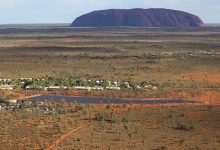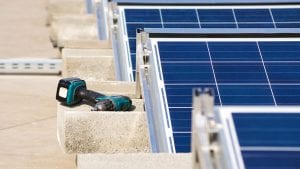The Northern Territory has a multi-billion dollar opportunity to invest massively in renewables, create a new hydrogen export industry, and create thousands of jobs, rather than following the controversial path of fracking vast reserves of gas.
That is the conclusion of a new report from Beyond Zero Emissions (BZE), entitled the “10 Gigawatt Vision for the Northern Territory”, which outlines a plan for the creation of up to 8,000 new jobs, by tapping into the territory’s rich solar resources, and supporting the creation of new energy export industries, including renewable hydrogen.
BZE predicts that renewable hydrogen could generate $2 billion in export revenues by 2030, should the NT government embrace renewables, and put in place a target for 10GW of renewable energy by 2030.
The report was launched at Parliament House in Darwin on Thursday by the territory’s minister of renewables Dale Wakefield, who was supportive of the project after being briefed on Wednesday. The launch was followed by a business round-table.
“Tapping into the NT’s nearly unlimited potential to generate renewable energy is an ideal solution to the territory’s quest to build a strong, resilient economy for its people and give them a good quality of life, ” CEO of Beyond Zero Emissions, Vanessa Petrie said.
“A renewables-powered electricity system would make energy-intensive sectors like mining and manufacturing more cost-efficient, and attract businesses to the territory. Replacing diesel machinery and vehicles with electric models would reduce health risks for workers.
“An ambitious renewable energy goal, combined with the Territory’s strategic location, can also unlock new opportunities such as meeting the world’s growing hunger for renewable hydrogen, exporting renewable electricity to growing Asian economies and adding significant value to exports through mineral processing.”
The Northern Territory has had a mixed experience with renewable energy.
Parts of the territory have strongly embraced renewables; Alice Springs in particular, which has passed 40 per cent renewable energy penetration within its grid. At the same time, the previous NT government ran scare campaigns over the costs of taking the grid to 100 per cent renewables, using an over-the-top figure of $2 billion, and openly backed the growth of gas fracking.
The current Labor government has a 50 per cent renewables target by 2030 for the electricity grid, but not much has happened to see that realised.
The BZE report paints a new vision; not only does renewable energy provide a huge opportunity for the NT to lower its energy costs, it could also provide a huge boom for its struggling economy.
An abundance of high-quality solar resources, and close proximity to Australia’s south-Asian neighbours, means the NT is ideally placed to serve as an Australian hub for renewable energy exports.
These exports might not just come in green hydrogen, it could include using cheap wind and solar to value add products, such as turning manganese ore into manganese metals, as Element 25 is proposing to do at the Butcherbird project in the Pilbara region, in Western Australia.
BZE sees the NT government’s headlong push into shale gas and fracking as a substantial risk to the territory’s economy, that it says would undermine otherwise beneficial measures to reduce greenhouse gas emissions, while only providing a short-term sugar hit to the NT economy.
The report points to the Ichthys LNG project at Baldwin Point near Darwin. Employment in the $34 billion project has slumped to just 300 ongoing full-time jobs, after an initial boom of 8,000 workers during construction. The subsequent decline in employment had serious flow-on effects for the NT economy, with house prices and government stamp duty revenues collapsing.
BZE points out that the Ichthys project received a $150 million loan from the federal government’s Export Finance and Insurance Corporation, and suggests that such financial support would be better directed towards enabling growth in the renewables sector.
“The best option for such assistance is often planning and funding of supporting infrastructure. One example might be an HVDC transmission line between Darwin and Alice Springs. Other possibilities are ports, road and railways to facilitate transport of minerals,” the report said.
BZE estimates that by growing the NT’s renewable generation capacity to 10GW, the NT government could stimulate the production of renewable hydrogen, representing a multi-billion dollar export opportunity, that could deliver dividends for the territory, while also creating thousands of jobs.
The benefits of lower energy prices that can be achieved through greater renewable energy adoption would have flow-on benefits for the manufacturing and minerals extraction and processing facilities located within the Territory. By shifting operations from costly gas and diesel fuel supplies, industries located within the territory would benefit, supporting additional job opportunities.
The Northern Territory currently pays some of the highest electricity prices in Australia, which is due, in part, to the remote nature of large parts of the territory’s electricity network and a large dependence on gas and diesel for electricity generation, which has left consumers exposed to rising fuel costs.
BZE sees strong investment in renewable energy as an opportunity to achieve significant cost reductions for energy users, including substantial decreases in household electricity costs.
“However you look at it, renewable energy is a strong and stable foundation for the Territory to build its economy on, unlike shale gas and other fossil fuels, which have a bleak outlook as investors and business fall out of love with fossil fuels,” director of Environment Centre NT Shar Molloy said.
“The NT is also feeling the impacts of climate change, which is driven by the burning of coal, oil, and gas. Keeping fossil fuels in the ground and pursuing low-carbon growth instead will mean that economic growth in the NT won’t come at the cost of people’s welfare.”
The Northern Territory government has set a target of reaching 50 per cent renewable energy by 2030, and has entered into agreements for the construction of new large-scale solar and battery storage systems throughout the territory.
This includes government owned Jacana Energy securing a power purchase agreement with a 25 MW solar farm near Katharine, and issuing a request-for-tender for the installation of up to 45MW of energy storage capacity to support the Darwin-Katharine power grid.
Read: Why the NT should choose 100% renewables, instead of fracked gas, by Beyond Zero Emissions chair Eytan Lenko











